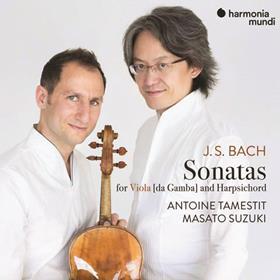Well-rounded recital taps a divine fountain of music

The Strad Issue: October 2019
Description: Well-rounded recital taps a divine fountain of music
Musicians: Antoine Tamestit (viola) Masato Suzuki (harpsichord)
Works: BACH Sonatas for viola and harpsichord BWV1027–1029; Aria ‘Ergieße dich reichlich, du göttliche Quelle’ BWV5
Catalogue Number: HARMONIA MUNDI HMM 902259
For this traversal of Johann Sebastian Bach’s viola da gamba music, Antoine Tamestit has gut-strung the ‘Mahler’ Stradivari (see July 2019) and plays it with a bespoke copy of a historic bow. With the instrument tuned at a lower pitch that audibly agrees with it, Tamestit almost uncannily evokes the sound world of the viola da gamba through his thoughtful fingering choices and sophisticated bowing. Although the music, with very few exceptions, fits exactly the viola’s register, Tamestit has introduced some changes of octave that facilitate following Bach’s three-part writing, all the more so since the unobtrusively excellent balance of the recording has the viola comfortably nestled within the harpsichord’s sound.
Tamestit has an ideal partner in Masato Suzuki, who is just as comfortable launching a brisk fugato as he is accompanying passages such as the haunting B minor slow movement from BWV1028. Both players are highly sensitive to the affekt expressed by the music at any given moment. The way Tamestit varies the timbre of a sustained note in reaction to the changing harmonies around it, or the tiny luftpause he introduces as the buoyant finale of BWV1028 turns towards the minor mode, are the work of a master colourist. The aria from Bach’s Cantata BWV5 – the singer’s part has been worked into the harpsichord – is one of his few original viola works. Its flowing semiquavers, depicting the ‘divine fountain’ mentioned in the text, are interpreted by Tamestit with a nicely springing stroke in a most attractive encore to a well-rounded recital.
CARLOS MARÍA SOLARE










































No comments yet